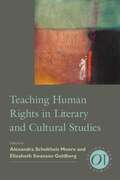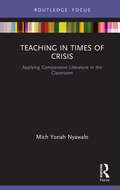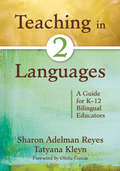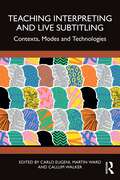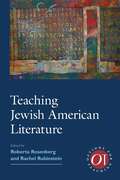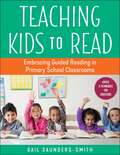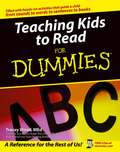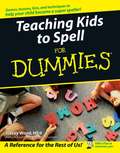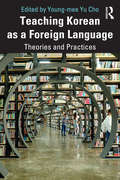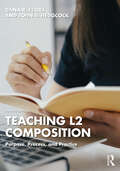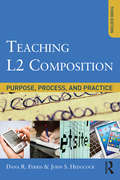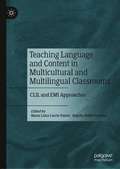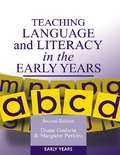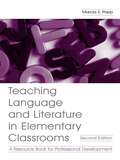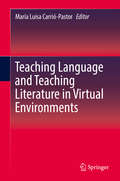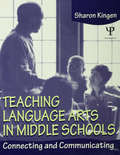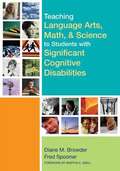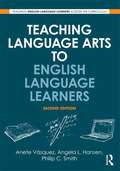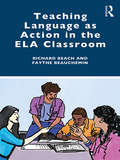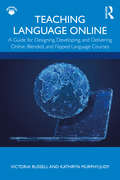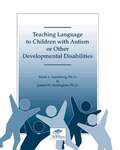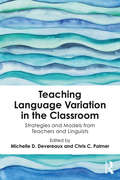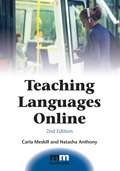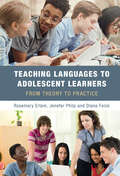- Table View
- List View
Teaching Human Rights in Literary and Cultural Studies (Options for Teaching #38)
by The Modern Language Association of AmericaSince the adoption of the Universal Declaration of Human Rights of 1948, the discourse of human rights has expanded to include not just civil and political rights but economic, social, cultural, and, most recently, collective rights. Given their broad scope, human rights issues are useful touchstones in the humanities classroom and benefit from an interdisciplinary and cross-cultural pedagogy in which objects of study are situated in historical, legal, philosophical, literary, and rhetorical contexts. Teaching Human Rights in Literary and Cultural Studies is a sourcebook of inventive approaches and best practices for teachers looking to make human rights the focus of their undergraduate and graduate courses.Contributors first explore what it means to be human and conceptual issues such as law and the state. Next, they approach human rights and related social-justice issues from the perspectives of particular geographic regions and historical eras, through the lens of genre, and in relation to specific rights violations--for example, storytelling and testimonio in Latin America or poetry created in the aftermath of the Armenian genocide. Essays then describe efforts to cultivate students' capacity for ethical reading practices and to deepen their understanding of the stakes and artistic dimensions of human rights representations, drawing on active learning and experimental class contexts. The final section, on resources, directs readers to further readings in history, criticism, theory, and literary and visual studies and provides a chronology of human rights legal documents.
Teaching in Times of Crisis: Applying Comparative Literature in the Classroom (Routledge Studies in Comparative Literature)
by Mich Yonah NyawaloTeaching in Times of Crisis explores how comparative methods, which are instrumental in reading and teaching works of literature from around the world, also provide us with tools to dissect and engage the moments of crises that permeate our contemporary political realities. The book is written in the form of a series of classroom reflections—or memos—capturing the political environment preceding and proceeding the 2016 US presidential election. It examines the ways in which the ethics involved in reading comparatively can be employed by teachers and students alike to map and foster "lifelines for cultural sustainability" (to borrow the term from Djelal Kadir’s Memos from the Besieged City) that are essential for creating and maintaining a healthy multicultural society. Nyawalo achieves this through comparative readings of postcolonial films, LGBTQ texts, French slam poetry, as well as episodes from Star Trek: The Next Generation, among other materials. The classroom reflections captured in each memo are shaped by the Appalachian setting in which the discussions and lessons took place. Inspired by this setting, the author develops pedagogic ethics of comparison—a method of reading comparatively—which privileges the local educational spaces in which students find themselves by mapping the contested cultural politics of Appalachian realities onto a world literature curriculum.
Teaching in Two Languages: A Guide for K–12 Bilingual Educators
by Sharon Adelman Reyes Tatyana KleynGrounded in the latest research, this book provides classroom-ready strategies for balancing instruction in two languages and meeting the unique challenges of educating English language learners.
Teaching Interpreting and Live Subtitling: Contexts, Modes and Technologies
by Carlo Eugeni Martin Ward Callum WalkerTeaching Interpreting and Live Subtitling: Contexts, Modes and Technologies provides a cross section of multinational perspectives on teaching various dimensions of interpreting and live subtitling, both within dedicated programmes and as part of individual modules on interpreting and/or live subtitling-adjacent programmes.Interpreting training and live subtitling training have been undergoing rapid and far-reaching transformations in recent years because of technological advances and the sweeping shifts in the contexts within which they seek to mediate, ultimately bringing about new modes. This volume covers the broad spectrum of interpreting and live subtitling trainings and discusses the possibility of how a more unified approach to training for live subtitlers and interpreters could lead to a future where the topics merge to become a single, complementary specialised stream of training that brings live subtitling equally into the forefront of the translation teaching field.The book provides an overview of the role played by technology in interpreting in general and uses up-to-date perspectives and research to ensure that interpreting and live subtitling training remains robust and resilient far into the 21st century. It will be of particular interest to professionals, scholars and teachers of translation studies and interpreting studies.
Teaching Jewish American Literature (Options for Teaching #49)
by Roberta Rosenberg and Rachel RubinsteinA multilingual, transnational literary tradition, Jewish American writing has long explored questions of personal identity and national boundaries. These questions can engage students in literature, writing, or religion; at Jewish, Christian, or secular schools; and in or outside the United States.This volume takes an expansive view of Jewish American literature, beginning with writing from the earliest colonies in the Americas and continuing to contemporary Soviet-born authors in the United States, including works that engage deeply with religious concepts and others that embrace assimilation. It invites readers to rethink the nature of American multiculturalism, suggests pairings of Jewish American texts with other ethnic American literatures, and examines the workings of whiteness and privilege.Contributors offer varied perspectives on classic texts such as Yekl, Bread Givers, and "Goodbye, Columbus," along with approaches to interdisciplinary topics including humor, graphic novels, and musical theater. The volume concludes with an extensive resources section.
Teaching Kids to Read: Embracing Guided Reading in Primary School Classrooms
by Gail Saunders-Smith"A solid resource to help teachers understand the basic foundation for literacy development through guided reading in the primary grade." —Patti Ulshafer, first-grade teacherDevelop successful readers with these strategies for before, during, and after reading. In Teaching Kids to Read, Gail Saunders-Smith describes the cognitive processes of emergent readers and provides educators with clear guidelines for promoting reading comprehension with small groups of young learners. A variety of exercises included helps children to locate, record, retrieve, and manipulate information from texts while enabling teachers to measure how students respond in oral, written, graphic, and three-dimensional forms. Topics covered include:AliteracyCoaching statementsElements of craftFalse positive readersFresh textGuided readingInstructional practiceMetacognitionPhonemic awarenessSelf-monitoringShared readingSight wordsStudy skillsTeacher talkWorkable wordsand more!
Teaching Kids to Read For Dummies
by Tracey Wood MedYou're thinking of teaching a child to read. What a great idea! Now all you need is exactly the right blueprint. This easy-to-follow book is written with two people in mind; you, and the child you're thinking of teaching. Mother and children's reading specialist Tracey Wood gives you all the down-to-earth, honest information you need to give a child a happy, solid start with reading. Teaching Kids to Read For Dummies is for parents of young children who want to give their kids a head start by teaching them to read before they enter school or to supplement their children's school instruction, as well as teachers and caregivers of young children. Filled with hands-on activities that progress a child from sounds to words to sentences to books, this friendly guide shows you how to: Prepare a child to read Sharpen his listening skills Correct her errors graciously Choose the right books Have kids read out loud Find help if you need it Whether the child you want to teach is two or twelve; fast paced or steady; an absolute beginner or someone who's begun but could use a little help, this empathetic book shows you how to adapt the simple, fun activities to your child's individual needs. You'll see how to make activities age appropriate, how to add more challenge or support, and how to make gender allowances if that's relevant. Plus, you'll discover how to: Lay the foundation for good reading skills Tell the difference between a reading delay and a reading problem Help your child build words from letters and sounds, advance to short and long vowel words, and conquer syllables and silent letters Select entertaining workbooks, recycle them, and make up your own reading activities Get your child ready for sentences Keep your child reading - with others or on his own Complete with lists of word families, phonics rules, and reading resources, Teaching Kids to Read For Dummies will help you make learning fun for your child as he or she develops this critical skill!
Teaching Kids to Spell For Dummies
by Tracey Wood MedFilled with enjoyable spelling activities and exercises The fun and easy way? to help your K-5th grader become an A+ speller If you want to make spelling easier for your child or boost spelling skills and confidence, you've come to the right place. Veteran reading specialist Tracey Wood gives you tips, games, exercises, word lists, and memory aids to help your child build solid spelling know-how. Her techniques are fun, fast, and effective, and best of all, they're not boring! Discover how to * Mix spelling practice with reading and writing * Spell short and long vowel words * Make spelling easier with word families * Gain insight into "sight" words * Break spelling into syllable chunks
Teaching Korean as a Foreign Language: Theories and Practices
by Young-mee Yu ChoTeaching Korean as a Foreign Language: Theories and Practices is designed for prospective or in-service Korean as a Foreign Language (KFL) teachers. With contributions from leading experts in the field, readers will gain an understanding of the theoretical framework and practical applications of KFL education in the context of Second Language Acquisition (SLA). The eight chapters explore the history of and current issues in language education, the practicalities of being a classroom teacher, and teaching and evaluation techniques for developing language and cultural proficiency. This comprehensive volume also includes an annotated bibliography which lists over 500 of the most recent and pertinent research articles and doctoral dissertations in the area. This bibliography will be of great service to students, teachers, and any researchers in applied linguistics and second language acquisition interested in Korean language education.
Teaching L2 Composition: Purpose, Process, and Practice
by Dana R. Ferris John S. HedgcockThis popular, comprehensive theory-to-practice text helps teachers understand the task of writing, L2 writers, the different pedagogical models used in current composition teaching, and reading-writing connections. Moving from general themes to specific pedagogical concerns, it includes practice-oriented chapters on the role of genre, task construction, course and lesson design, writing assessment, feedback, error treatment, and classroom language (grammar, vocabulary, style) instruction. Each chapter includes Questions for Reflection, Further Reading and Resources, Reflection and Review, and Application Activities. An ideal text for L2 teacher preparation courses and in-service writing instructors, the text offers an accessible synthesis of theory and research that enables readers to see the relevance of the field’s knowledge base to their own present or future classroom settings and student writers. New to the Fourth Edition: Updated with new research, theory, and developments in the field throughout the text Visually accessible layout and design for improved reader navigability Expanded attention to technological affordances for writing pedagogy Stand-alone reference list in each chapter Support Material with activities and resources from the text also available on the book’s webpage at www.routledge.com/9780367436780
Teaching L2 Composition: Purpose, Process, and Practice
by John Hedgcock Dana R. FerrisThis popular, comprehensive theory-to-practice text is designed to help teachers understand the task of writing, L2 writers, the different pedagogical models used in current composition teaching, and reading–writing connections. Moving from general themes to specific pedagogical concerns, it includes practice-oriented chapters on the role of genre, task construction, course and lesson design, writing assessment, feedback, error treatment, and classroom language (grammar, vocabulary, style) instruction. Although all topics are firmly grounded in relevant research, a distinguishing feature of the text is the array of hands-on, practical examples, materials, and tasks that pre- and in-service teachers can use to develop the complex skills involved in teaching second language writing. Each chapter includes Questions for Reflection, Further Reading and Resources, Reflection and Review, and Application Activities. An ideal text for L2 teacher preparation courses, courses that include both L1 and L2 students, and workshops for instructors of L2 writers in academic (secondary and postsecondary) settings, the accessible synthesis of theory and research enables readers to see the relevance of the field’s knowledge base to their own present or future classroom settings and student writers.
Teaching Laboring-Class British Literature of the Eighteenth and Nineteenth Centuries (Options for Teaching #43)
by Kevin Binfield William J. ChristmasBehind our contemporary experience of globalization, precarity, and consumerism lies a history of colonization, increasing literacy, transnational trade in goods and labor, and industrialization. Teaching British laboring-class literature of the eighteenth and nineteenth centuries means exploring ideas of class, status, and labor in relation to the historical developments that inform our lives as workers and members of society. This volume demonstrates pedagogical techniques and provides resources for students and teachers on autobiographies, broadside ballads, Chartism and other political movements, georgics, labor studies, satire, service learning, writing by laboring-class women, and writing by laboring people of African descent.
Teaching Language and Content in Multicultural and Multilingual Classrooms: CLIL and EMI Approaches
by María Luisa Carrió-Pastor Begoña Bellés-FortuñoThis edited book explores critical issues relating to Content and Language Integrated Learning (CLIL) and English as a Medium of Instruction (EMI), setting out their similarities and differences to demystify the terms and their implications for classroom practice. The authors show how CLIL and EMI practices are carried out in different institutional contexts and demonstrate how both approaches can benefit language and content acquisition. This book is addressed to second/foreign language teaching staff involved in teaching in English at primary education, secondary education, and higher education levels.
Teaching Language and Literacy in the Early Years
by Margaret Perkins Diane GodwinThe early years are increasingly recognized as a priority time for the education of children and language and literacy are key elements of any early childhood program. This second edition provides an accessible text on the current research and thinking surrounding these areas and demonstrates clearly how this theory can work in practice. The authors provide guidance on planning, assessment and recording; suggest appropriate activities, resources and play ideas to help those who work with or are planning to work within the foundation stage. The second edition includes specific reference to both the curriculum guidance for the Foundation Curriculum and the framework of teaching objectives for the National Literacy Strategy and puts these within a framework which acknowledges the centrality of play and talk in the early years. The book is firmly grounded in the requirements of the Foundation curriculum and is a suitable textbook for undergraduate early childhood courses, all those following routes into early years teaching, and existing practitioners in all types of early years settings. The book will also be appropriate reading for LEA advisers and those who inspect early years settings.
Teaching Language and Literature in Elementary Classrooms: A Resource Book for Professional Development
by Marcia S. PoppThe goal of this book -- a theoretically based, well-organized, useful guide for teaching -- is to help the beginning teacher create a classroom environment that integrates literacy development with learning in all areas of the curriculum. The major components of an integrated language program are identified, and the skills teachers need to implement this kind of program in their own classrooms are described. Designed to be kept and used as a resource in the classroom, this text provides fundamental information about language arts teaching. A constructivist orientation, an emphasis on teachers as reflective decision makers, and vivid portrayals of the classroom as a community of learners and inquirers are woven throughout the book. Key features include: * a wealth of models, suggestions, and step-by-step guidelines for introducing integrated teaching and learning practices into elementary classrooms at the kindergarten, primary, and intermediate levels; * a focus on relevant research in language arts and professional teacher development; * true-to-life classroom narratives that model instructional strategies and demonstrate interactions between real teachers and students; and * an innovative chapter format that makes the text accessible as a resource for student, beginning, and experienced teachers.
Teaching Language and Teaching Literature in Virtual Environments
by María Luisa Carrió-PastorThis book sheds new light on language and literature teaching, and offers examples of teaching language in virtual environments. Providing an overview of virtual environments for teaching, it also includes chapters devoted to methodology design for second language teaching in these environments. Further it describes tools for second/ foreign language teaching and proposals for specific second language teaching in virtual environments. Lastly, it presents experiments on literature teaching in virtual environments and discusses the future of technology in education. With interdisciplinary appeal, the book is a particularly valuable resource for scholars with an interest in technology, language teaching and literature teaching.
Teaching Language Arts in Middle Schools: Connecting and Communicating
by Sharon KingenThis text is designed specifically to meet the needs of preservice teachers who have had little experience working in middle-grade classrooms. Three ideas are central: * teaching language arts at the middle level is a complex activity that demands expertise in the use of a variety of strategies, * reading and writing are key processes of language arts study, but so are speaking, listening, and viewing/visually representing, and * teaching the processes of effective communication is crucial, but middle school students must also begin to learn the content of the field--literature, language, and media. Teaching Language Arts in Middle Schools gives balanced attention to various teaching strategies, processes, and content, demonstrating how all of these connect to improve students' abilities to communicate. In this text: *Research and theory are summarized and applied to practice *A non-prescriptive approach is integrated with practical information *Debates in the field are acknowledged *Additional reading and research are emphasized *The author's voice and point of view are explicit
Teaching Language Arts, Math, and Science to Students With Significant Cognitive Disabilities
by Diane M. Browder Fred SpoonerUnder NCLB, students with severe disabilities are expected to make progress on state academic content standards in language arts, math, and science. But what material should educators teach from these three content areas, and how should they teach it? With this groundbreaking textbook, future educators will have the answers they need. The first major research-to-practice resource on this critical topic, this text goes beyond functional and access skills and shows educators how to make the general curriculum accessible to students of all ages with significant cognitive disabilities. Twenty-five of the best-known researchers in the field prepare educators to - adapt lessons in language arts, math, and science for students with disabilities - identify meaningful instructional content - create effective learning environments through instructional procedures such as peer tutoring, cooperative learning, and co-teaching - set appropriate expectations for student achievement - align instruction with state content standards and alternate assessment For each content area, future teachers will get a solid research foundation blended with teaching examples, guidelines, and helpful figures and tables. A timely textbook for pre-service educators--and a valuable reference for in-service teachers seeking guidance--this important resource will raise expectations for students with disabilities and ensure their progress in key academic areas. Learn how to teach - Language Arts. Move beyond sight-word recognition and teach the literacy components identified by the National Reading Panel - Math. Help students learn higher-level math concepts such as problem solving, reasoning, connections, and representations, as well as functional skills - Science.
Teaching Language Arts to English Language Learners
by Anete Vásquez Angela L. Hansen Philip C. SmithThis thoroughly revised and updated edition of Teaching Language Arts to English Language Learners provides readers with the comprehensive understanding of both the challenges that face ELLs and ways in which educators might address them in the language arts classroom. The authors offer proven techniques that teachers can readily use to teach reading, writing, grammar, and vocabulary as well as speaking, listening, and viewing skills. A complete section is also devoted to ways teachers can integrate all five strands of the language arts curriculum into a comprehensive unit of study with meaningful accommodations for ELLs. An annotated list of web and print resources completes the volume, making this a valuable reference for language arts teachers to meet the challenges of including all learners in effective instruction. New features to this edition include: An updated and streamlined Part 1, which provides an essential overview of ELL theory in a language arts specific context. Additional practical examples of language arts exercises, all of which are closely aligned with the Common Core State Standards. New pedagogical elements in Part 3, including tips on harnessing new technologies, discussion questions and reflection points. Updates to the web and print resources in Part 4
Teaching Language as Action in the ELA Classroom
by Richard Beach Faythe BeaucheminThis book explores English language arts instruction from the perspective of language as "social actions" that students and teachers enact with and toward one another to create supportive, trusting relations between students and teachers, and among students as peers. Departing from a code-based view of language as a set of systems or structures, the perspective of languaging as social actions takes up language as emotive, embodied, and inseparable from the intellectual life of the classroom. Through extensive classroom examples, the book demonstrates how elementary and secondary ELA teachers can apply a languaging perspective. Beach and Beauchemin employ pedagogical cases and activities to illustrate how to enhance students’ engagement in open-ended discussions, responses to literature, writing for audiences, drama activities, and online interactions. The authors also offer methods for fostering students' self-reflection to improve their sense of agency associated with enhancing relations in face-to-face, rhetorical, and online contexts.
Teaching Language Online: A Guide for Designing, Developing, and Delivering Online, Blended, and Flipped Language Courses
by Victoria Russell Kathryn Murphy-JudyPractical and accessible, this book comprehensively covers everything you need to know to design, develop, and deliver successful online, blended, and flipped language courses. Grounded in the principles of instructional design and communicative language teaching, this book serves as a compendium of best practices, research, and strategies for creating learner-centered online language instruction that builds students’ proficiency within meaningful cultural contexts. This book addresses important topics such as finding and optimizing online resources and materials, learner engagement, teacher and student satisfaction and connectedness, professional development, and online language assessment. Teaching Language Online features: A step-by-step guide aligned with the American Council on the Teaching of Foreign Languages (ACTFL), the Common European Framework of Reference (CEFR) for Languages: Learning, Teaching and Assessment, and the World-Class Instructional Design and Assessment (WIDA) standards Research-based best practices and tools to implement effective communicative language teaching (CLT) online Strategies and practices that apply equally to world languages and ESL/EFL contexts Key takeaway summaries, discussion questions, and suggestions for further reading in every chapter Free, downloadable eResources with further readings and more materials available at www.routledge.com/ 9781138387003 As the demand for language courses in online or blended formats grows, K-16 instructors urgently need resources to effectively transition their teaching online. Designed to help world language instructors, professors, and K-12 language educators regardless of their level of experience with online learning, this book walks through the steps to move from the traditional classroom format to effective, successful online teaching environments.
Teaching Language To Chidren With Autism Or Other Developmental Disabilities
by Mark L. Sundberg James W. PartingtonThis is the original must have book for professionals and parents implementing a verbal behavior assessment and intervention program for children with autism or other developmental disabilities (often termed the Verbal Behavior Approach). The book provides an easy to understand introduction to Skinner s analysis of language (i.e., mands, tacts, & intraverbals) with easy to follow examples of everyday language skills demonstrated by children. The book contains a brief language assessment system; the Behavioral Language Assessment Form (BLAF) that will give parents and teachers a quick overview of a child s language skills (see the VB-MAPP for a more thorough assessment). The assessment is followed by descriptions on the basic teaching procedures for developing early and intermediate mands, tacts, echoics, imitation, matching-to-sample, receptive language, and intraverbal skills. The use of sign language and other forms of augmentative communication are presented along with suggestions for IEP goals, skill tracking, and data collection. The book also contains a chapter on the need for both structured discrete trial training (DTT) and natural environment training (NET). This is the latest version of the book and has been re-edited (2010), and professionally typeset thus it is 70 pages less than the original version released in 1998. This version (7.2) is exclusively published by AVB Press.
Teaching Language Variation in the Classroom: Strategies and Models from Teachers and Linguists
by Michelle D. Devereaux Chris C. PalmerBringing together the varied and multifaceted expertise of teachers and linguists in one accessible volume, this book presents practical tools, grounded in cutting-edge research, for teaching about language and language diversity in the ELA classroom. By demonstrating practical ways teachers can implement research-driven linguistic concepts in their own teaching environment, each chapter offers real-world lessons as well as clear methods for instructing students on the diversity of language. Written for pre-service and in-service teachers, this book includes easy-to-use lesson plans, pedagogical strategies and activities, as well as a wealth of resources carefully designed to optimize student comprehension of language variation.
Teaching Languages Online
by Carla Meskill Natasha AnthonyNovice and experienced educators who have considered moving some or all of their language courses online will find this text an invaluable starting point and resource throughout the process. In non-technical prose with emphasis throughout on excellence in pedagogical practice, the text takes both the new and experienced language instructor through the nuts and bolts of online teaching practices and uses multiple examples of online instructional conversations to illustrate these practices. Teaching in asynchronous written, asynchronous aural, synchronous written, synchronous aural and combinations of these environments are discussed and exemplary practices provided for each. An excellent place to both begin and augment language teaching online.
Teaching Languages to Adolescent Learners: From Theory to Practice
by Rosemary Erlam Jenefer Philp Diana FeickTeaching languages to adolescents can be a challenge. . . but one that is most rewarding! What works? What doesn't work? This book provides a reader friendly overview on teaching modern languages to adolescents (Years 7–13). Each chapter takes an aspect of language teaching and learning, and explains the underlying theory of instructed language acquisition and its application through examples from real language classrooms. The book explores teachers' practices and the reasoning behind their pedagogic choices through the voices of both the teachers themselves and their students. At the same time, it highlights the needs of the adolescent language learner and makes the case that adolescence is a prime time for language learning. Written in an accessible, engaging way, yet comprehensive in its scope, this will be essential reading for language teachers wishing to integrate cutting-edge research into their teaching. This title is also available as Open Access on Cambridge Core at 10.1017/9781108869812
